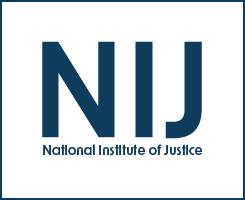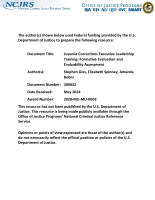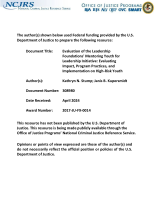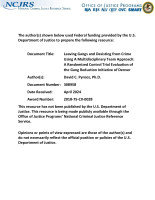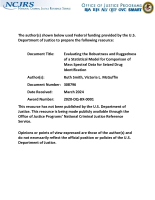Program evaluation
Using Intelligence Analysis to Understand and Address Fentanyl Distribution Networks in America’s Largest Port City
Assessing the Impact of an Innovative Response to Intimate Partner Violence Related Strangulation, Process Evaluation
Assessing the Impact of an Innovative Response to Intimate Partner Violence Related Strangulation, Final Report & Outcome Evaluation
Evaluating Technology-Based Services for Victims of Crime
NIJ FY24 Invited to Apply - American Association for the Advancement of Science (AAAS) Science & Technology Policy Fellowships (STPF)
Understanding the Impact of COVID-19 on Victim Services
The COVID-19 pandemic had a detrimental impact on communities across the nation and significantly affected various aspects of individuals’ lives. One of the negative impacts was an increase in gender-based violence accompanied by shifting barriers to accessing services and support. Victims and victim service providers faced various challenges dealing with the increase in need for services, navigating barriers to help-seeking, and addressing logistical issues.
See the YouTube Terms of Service and Google Privacy Policy
Applying a Developmental Evaluation Approach to Address Community Safety and Health Challenges of Reintegration Programs in the USA
Understanding the Potential for Multidisciplinary Threat Assessment and Management Teams to Prevent Terrorism: Conducting a Formative Evaluation of the MassBay Threat Assessment Team
Juvenile Corrections Executive Leadership Training: Formative Evaluation and Evaluability Assessment
Evaluation of the Leadership Foundations' Mentoring Youth for Leadership Initiative: Evaluating Impact, Program Practices, and Implementation on High-Risk Youth
Evaluation of a Principal Training Program to Promote Safe and Civil Schools
Leaving Gangs and Desisting from Crime Using a Multidisciplinary Team Approach: A Randomized Control Trial Evaluation of the Gang Reduction Initiative of Denver
Evaluating and Assessing Terrorism Prevention Programs: What Research Sponsored by the National Institute of Justice Tells Us
Offering Recovery Rather Than Punishment: Implementation of a Law Enforcement-led Pre-arrest Diversion-to-treatment Program for Adults with Substance Use Disorders
Contexts and Characteristics of Imaged-Based Sexual Exploitation and Abuse of Children: Incident Dynamics in a National Sample
Pranks, Obscene Chatters, and Ambiguous Content: Exploring the Identification and Navigation of Inappropriate Messages to a Web-Based Sexual Assault Hotline
Webinar Transcript: NIJ FY 2024 Research and Evaluation on School Safety
This webinar provided information on the NIJ FY 2024 Research and Evaluation on School Safety solicitation. In collaboration with BJA, this solicitation will seek applications for rigorous research and evaluation projects to fill knowledge gaps in two topical areas:
- Studies on the root causes and consequences of school...
Evaluating the Robustness and Ruggedness of a Statistical Model for Comparison of Mass Spectral Data for Seized Drug Identification
Webinar Transcript: NIJ FY 2024 Research and Evaluation on Youth Justice Topics
This webinar will provide an overview of the NIJ FY 2024 Research and Evaluation on Youth Justice Topics solicitation. In collaboration with the Office of Juvenile Justice and Delinquency Prevention, NIJ seeks applications for research and evaluation projects that inform policy and practice in the field of...
Webinar Transcript: NIJ FY 24 Research and Evaluation on the Impact of Technologies for Forensic Science Applications
This webinar provided information about the "FY 24 Research and Evaluation on the Impact of Technologies for Forensic Science Applications" solicitation. NIJ seeks applications for funding for proposals to study how adopted technologies with a forensic science application impact criminal justice systems, how the implementation of forensic laboratory...



